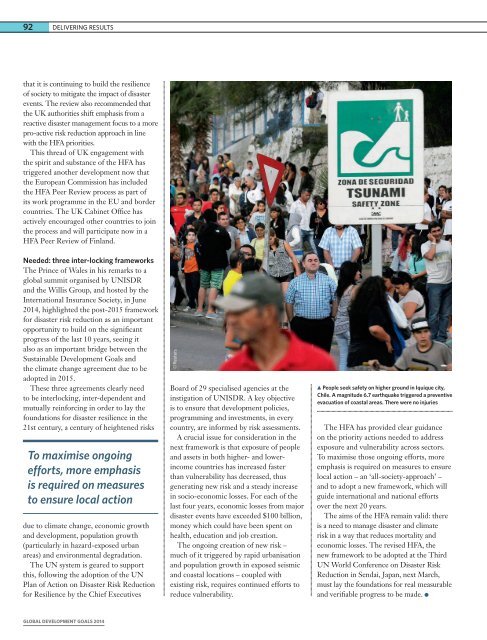FAMBB
FAMBB
FAMBB
Create successful ePaper yourself
Turn your PDF publications into a flip-book with our unique Google optimized e-Paper software.
92 DELIVERING RESULTSthat it is continuing to build the resilienceof society to mitigate the impact of disasterevents. The review also recommended thatthe UK authorities shift emphasis from areactive disaster management focus to a morepro-active risk reduction approach in linewith the HFA priorities.This thread of UK engagement withthe spirit and substance of the HFA hastriggered another development now thatthe European Commission has includedthe HFA Peer Review process as part ofits work programme in the EU and bordercountries. The UK Cabinet Office hasactively encouraged other countries to jointhe process and will participate now in aHFA Peer Review of Finland.Needed: three inter-locking frameworksThe Prince of Wales in his remarks to aglobal summit organised by UNISDRand the Willis Group, and hosted by theInternational Insurance Society, in June2014, highlighted the post-2015 frameworkfor disaster risk reduction as an importantopportunity to build on the significantprogress of the last 10 years, seeing italso as an important bridge between theSustainable Development Goals andthe climate change agreement due to beadopted in 2015.These three agreements clearly needto be interlocking, inter-dependent andmutually reinforcing in order to lay thefoundations for disaster resilience in the21st century, a century of heightened risksTo maximise ongoingefforts, more emphasisis required on measuresto ensure local actiondue to climate change, economic growthand development, population growth(particularly in hazard-exposed urbanareas) and environmental degradation.The UN system is geared to supportthis, following the adoption of the UNPlan of Action on Disaster Risk Reductionfor Resilience by the Chief Executives© ReutersBoard of 29 specialised agencies at theinstigation of UNISDR. A key objectiveis to ensure that development policies,programming and investments, in everycountry, are informed by risk assessments.A crucial issue for consideration in thenext framework is that exposure of peopleand assets in both higher- and lowerincomecountries has increased fasterthan vulnerability has decreased, thusgenerating new risk and a steady increasein socio-economic losses. For each of thelast four years, economic losses from majordisaster events have exceeded $100 billion,money which could have been spent onhealth, education and job creation.The ongoing creation of new risk –much of it triggered by rapid urbanisationand population growth in exposed seismicand coastal locations – coupled withexisting risk, requires continued efforts toreduce vulnerability.People seek safety on higher ground in Iquique city,Chile. A magnitude 6.7 earthquake triggered a preventiveevacuation of coastal areas. There were no injuriesThe HFA has provided clear guidanceon the priority actions needed to addressexposure and vulnerability across sectors.To maximise those ongoing efforts, moreemphasis is required on measures to ensurelocal action – an ‘all-society-approach’ –and to adopt a new framework, which willguide international and national effortsover the next 20 years.The aims of the HFA remain valid: thereis a need to manage disaster and climaterisk in a way that reduces mortality andeconomic losses. The revised HFA, thenew framework to be adopted at the ThirdUN World Conference on Disaster RiskReduction in Sendai, Japan, next March,must lay the foundations for real measurableand verifiable progress to be made.GLOBAL DEVELOPMENT GOALS 2014


